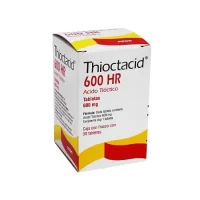$169.00
Manufacturer: Germany
Purpose: Alpha-lipoic acid antioxidant to treat neuropathy in diabetes.
Description
Thioctacid 600 HR (α-lipoic acid) Coated Tablets 600 mg. №100 Vial
Ingredients
Each coated tablet contains 600 mg of α-lipoic acid.
Dosage
The recommended dosage is one tablet daily, or as directed by a healthcare professional.
Indications
Thioctacid 600 HR is indicated for the treatment of diabetic neuropathy and as an antioxidant supplement.
Contraindications
Do not use Thioctacid 600 HR if you are allergic to α-lipoic acid or any other ingredients in the product.
Directions
Swallow the tablet whole with water, do not crush or chew it. Take it with or without food.
Scientific Evidence
Thioctacid 600 HR (α-lipoic acid) has been extensively studied for its antioxidant properties and its role in managing diabetic neuropathy. Research has shown that α-lipoic acid can improve neuropathic symptoms and reduce oxidative stress in diabetic patients. Clinical trials have demonstrated its efficacy in improving nerve conduction velocity and reducing pain associated with diabetic neuropathy.
In a study published in Diabetes Care, α-lipoic acid was found to significantly improve neuropathic symptoms compared to a placebo, highlighting its potential as a therapeutic option for diabetic neuropathy.
Additional Information
It is important to consult a healthcare provider before starting any new supplement, especially if you have underlying medical conditions or are taking other medications.
Thioctacid 600 HR is a well-tolerated supplement, but some individuals may experience mild gastrointestinal discomfort. If you experience any adverse reactions, discontinue use and consult your healthcare provider.
Related products
-

Ubichinon compositum (acidum acetylsalicylicum) solution for injection 2.2 ml vials №5
$59.00 Add to cart -

Trimetazidin (trimetazidine) coated tablets 20 mg. №60
$15.00 Add to cart -

Thioctacid 600 HR (α-lipoic acid) coated tablets 600 mg. №30 vial
$69.00 Add to cart -

Triductan MV (trimetazidine) coated tablets with prolonged release 35 mg. №20
$8.00 Add to cart



Recent Reviews